|
For touring in Xi'an , the most popular and important tourist attractions are the Terracotta Warriors, the Wild Goose Pagoda, the Bell Tower , the City Wall, the Huaqing Hot Spring and Banpo Village . For eating, the dumplings and noodles in Xi'an are very famous and delicious. For night entertainment you should go to see the Tang Dancing Show. For Shopping, it is necessary to purchase some replica statues of clay soldiers.
Tourist attractions in Xi'an:
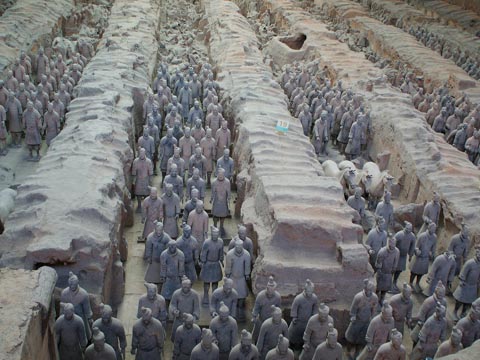 |
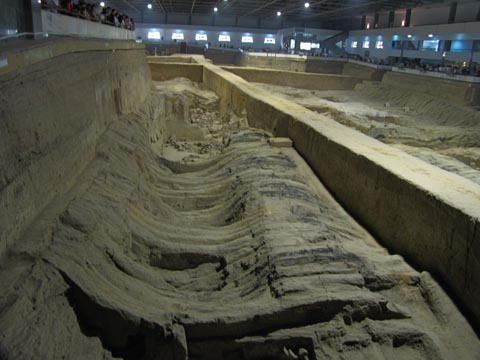 |
The
Terra Cotta Warriors and Horses Museum Pit1 |
The
Terra Cotta Warriors and Horses Museum Pit2 |
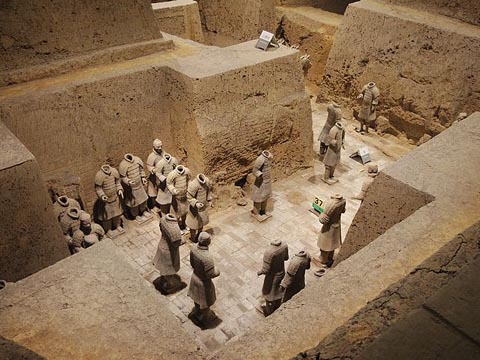 |
 |
The
Terra Cotta Warriors and Horses Museum Pit3 |
The
Bronze Horse Chariot |
 |
 |
Terra Cotta Warriors and Horses |
Terra
Cotta Warrior's Expression |
The Terra Cotta Warriors and Horses Museum lies 1.5 kilometers east of Emperor Qinshihuang’s Mausoleum in Lintong County of Xi’an city. The Terra Cotta army was found accidentally by the farmers in 1974 when they sunk a well. Later they were excavated by the archeologists. The museum was open to public in 1978. All together there are 3 pits excavated. There were 100 war chariots, 600 clay horses, nearly 7,000 life sized clay soldiers, and 30,000 weapons discovered.
Terra Cotta Pit 1 is oblong, 230 meters east to west, and 62 meters north to south. There are more than 6,000 terracotta warriors and horses, arrayed into battle line formation. Three columns facing out on the east, act as vanguard. The main body is behind. The rear guard is on the west. They are armed with crossbows.
Terra Cotta Pit 2 is in L-shaped formation, which is around 6000 square meters. There are around 1000 warriors, 500 horses and 89 wooden chariots discovered. Some warriors are archers, some are cavalries other are infantries.
Terra Cotta Pit 3 is quite small which covers an area of 520 square meters. A war chariot, 4 Terra Cotta horses and 68 warriors lined along the wall as honor guards were found. It is the supreme headquarters commanding the troops of Pit1 and Pit 2.
The Terra Cotta army and horses are very
impressive with the life-like expressions. They epitomize the power of
the armed forces of Qin. They also offered the tangible materials for
the study of equipments, military organization and battle arrays of the
Qin Dynasty.
The Terra Cotta warriors with varied colors and forms indicate vivid personalities
and traits. They represent a peak in the development of sculpture in ancient
China. The figures are of epoch-making significance in the history of
Chinese sculpture.
The discovery of the Terra Cotta warriors and horses aroused world-wide
attention. It has been called the Eighth Wonder of the World and the most
spectacular archeological find in the 20th Century. In 1987 it was listed
the world’s cultural heritages by UNESCO.
 Replica
terracotta warriors and horse on sale. If you have interest please contact
me.
Replica
terracotta warriors and horse on sale. If you have interest please contact
me.
This is one set of Terracotta warriors
and horse figurines. They are made of clay. The standing soldier is 16cm
high and 6cm wide. The horse is 14cm long and 12 cm high. The squatting
soldier is 12 cm high. They are put in a gift box. Including shipping
it costs 95USD including shipping.
The Big Wild Goose Pagoda was built in the Great Ci'en Temple
of the Tang Dynasty in 652A .D. It is 64 meters high with seven storeys.
It was used for storing the scriptures and Buddha's statues brought back
from India by Monk Xuanzang of the Tang Dynasty. This pagoda is simple
but of high architectural art. Above the stone doors at the bottom of
the pagoda, there remain the exquisite line-etched pictures from the Tang
Dynasty. Visitors can spiral up the pagoda to view the whole city. It
is the symbol of Xi'an.
The life and adventures of a Chinese monk who made a 17-year journey to
bring Buddhist teachings from India to China. Xuanzang subsequently became
a main character in the great Chinese epic Journey to the West.
 |
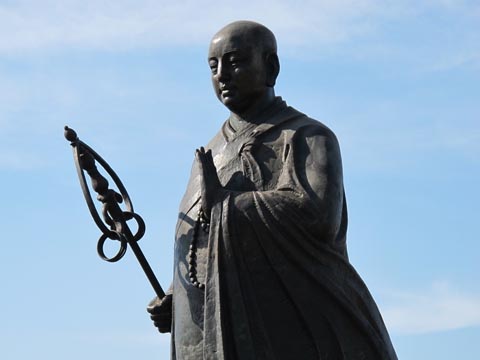 |
The
Wild Goose Pagoda |
Monk
Xuanzang |
More Story About Xuanzang
In 629 C.E., a Chinese Buddhist monk named Xuanzang wanted to go west
to India to learn more about Buddhism, but at the time, the emperor had
forbidden travel outside China. Xuanzang respected authority and he struggled
with a decision on whether or not to make the journey. Xuanzang, a brilliant
and devout man, in the end believed that going to India was the only way
to answer questions that troubled Chinese Buddhists. He started a seventeen-year
journey that year, much of it spent as a fugitive and traveling under
the cover of darkness.
Xuanzang traveled along what we now know as the Silk Road. He survived
the dangerous Taklamakan Desert and continued through the high and harsh
mountains of Tian Shan (literally, mountains of the heavens or sky). The
Silk Road took him through countries ruled by powerful leaders who sometimes
wanted to keep him in their kingdom rather than allow him to travel on.
His intelligence and calm devotion to Buddhism convinced these leaders
to help him in this quest to reach India. He was to have many adventures
as he worked his way through India, on to Nepal, the home of the Buddha,
and then to Nalanda where he spent many years living with the greatest
teachers and thinkers of this time. Before he returned home, Xuanzang
had converted pirates who meant to rob and kill him, survived deadly typhoons,
and won a Great Debate in front of thousands of wise men in India.
The return trip was no less difficult and he slowly made his way back
studying, teaching, and learning about the cultures of the people he met
along the way. Xuanzang was still officially a fugitive in his homeland,
China, because he had left without permission. Xuanzang wrote a letter
to the emperor describing what he had learned and as a result, the emperor
not only welcomed him back, but appointed him a court advisor.
The rest of Xuanzang's life was spent in teaching, advising and translating
manuscripts that made the journey home with him. Following his journey,
Buddhism became more prevalent and more widely understood in China and
subsequently elsewhere in the world. The record of his pilgrimage helps
us to study and understand Buddhism and the cultures along the Silk Roads.
The Old City Wall in Xi'an was built in 1374A.D on the basis
of the city of Chang'an in the Tang Dynasty. They are 11.9kilometres in
girth with the top widths of 12 to 14 meters. They are one of China’s
most historically—known city wall buildings remaining from the later stage
of the Middle Ages. They are built of grey bricks and kept intact. The
gate tower built over each of the four city gates and painted in dark
green, which looks lofty and magnificent and forms a tight defense engineering
system.
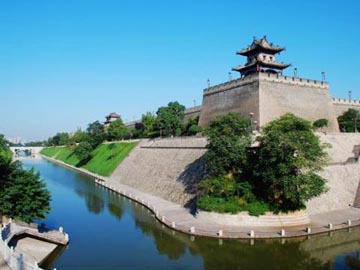 |
 |
Xi'an
Old City Wall |
Cycling
on the Xi'an City Wall |
History
Xi'an City Wall was erected in the 14th century Ming Dynasty, under the
regime of Emperor Zhu Yuanzhang. When Zhu Yuanzhang captured Huizhou,
long before the establishment of the Ming Dynasty, he was admonished by
a hermit named Zhu Sheng, who told him to "build high walls, store
abundant provisions and take your time in proclaiming yourself emperor."
This advice Zhu Yuanzhang heeded. Once the whole country was unified,
he sent orders to the local governments to build city walls on a large
scale. Zhu assured that "out of all the mountains and rivers in the
world, the area of Central Qin is the most strongly fortified and strategically
impregnable." The current city wall is an enhancement of the old
Tang Dynasty structure, as a result of the emperor's wall building campaign.
The Structure of the City Wall
The first city wall of Xi'an was built of earth, rammed layer upon layer.
The base layer was made of earth, quick lime, and glutinous rice extract,
tamped together. It made the wall extremely strong and firm. Later, the
wall was totally enclosed with bricks. A moat, wide and deep, ran around
the city. Over the moat, there used to be a huge drawbridge, which would
cut off the way in and out of the city, once lifted.
Xi'an's city wall, after its enlargement in the Ming Dynasty, stands 12
meters high. It is 12-14 meters across the top, 15-18 meters thick at
bottom, and 13.7 kilometers in length. There is a rampart every 120 meters.
The ramparts are towers that extend out from the main wall. The ramparts
were built to allow soldiers to see enemies trying to climb the wall.
The distance between the ramparts is within the range of arrows fired
from either side. This allowed soldiers to protect the entire wall without
exposing themselves to the enemy. There are altogether 98 ramparts; each
has a sentry building on top of it.
The Gates
The gates of the city wall were the only way to go into and out of town.
Therefore, these gates were important strategic points, which the feudal
rulers racked their brains to try to defend. In Xi'an's case, the north,
south, east and west gates, each consist of three towers: the gate tower,
which holds the drawbridge, the narrow tower and the main tower. The gate
tower stands proud of the wall. It is used to lift and lower the drawbridge.
The narrow tower is in the middle. Its inner walls have square windows
to shoot arrows from. The main tower is the innermost one, and forms the
entrance to the city.
Tunnels
The narrow tower and the main tower are connected by tunnels, in which
soldiers could be stationed. From the tunnels there are also horse passages
leading to the top of the wall. There are gradually ascending steps, made
so that it was easy for war horses to ascend and descend. There are all
together 11 horse passages around the city.
Watch Towers
A watch tower is located on each of the four corners of the wall. The
one at the southwestern corner is round, probably after the model of the
imperial city wall of the Tang Dynasty, but the other three are square-shaped.
On top of the watch towers there is a corner rampart, higher and larger
than the ordinary ramparts. This shows the strategic importance of the
corners of the city wall in war times.
Battlements
Along the outer crest of the city wall there are crenellations or battlements.
Under each of the 5,984 crenels there is a square hole, from which arrows
were shot and watch was kept. The lower, inner walls are called parapets.
They were used to prevent soldiers from falling off the wall, when traveling
back and forth.
The Drum Tower of Xi’an, located in the heart of Xi'an in Shaanxi
province of China, along with the Bell Tower it is a symbol of the city.
Erected in 1380 during the early Ming Dynasty, it stands towering above
the city center and offers incredible view of Xi'an.
The Drum Tower got its name from the huge drum located within the building.
In contrast to the Bell Tower, where bell was stricken at dawn, drum was
beat at sunset to indicate the end of the day.
On the Drum Tower's first floor, lies a hall which hangs many large drums.
Each was decorated with intrinsic and beautiful Chinese writing, which
symbolizes good fortune. The impressive arrays of drums are only on show
and visitors are not allowed to touch any of them. But there is an extra
drum near the front entrance where visitors can pose for pictures for
a small fee.
Inside the Drum Tower there is also a drum museum, where a variety of
drums are on display, some of which can be dated back thousands of years.
There is a drum show performed here every day. The top of the tower commands
a panoramic view of the city.
 |
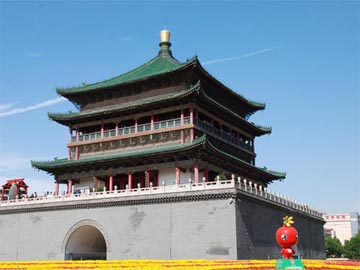 |
Xi'an
Drum Tower |
Xi'an
Bell Tower |
The Bell Tower of Xi'an,
built in 1384 during the early Ming Dynasty, is a symbol of the city of
Xi'an and one of the grandest of its kind in China. The Bell Tower also
contains several large bronze-cast bells from the Tang Dynasty. The tower
base is square and it covers an area of 1,377 square meters. The tower
is a brick and timber structure and close to 40 meters high.
There are several legends regarding the Bell Tower, one of them
tells:
In Ming Dynasty, several earthquakes struck Guanzhong area, thousands
were dead and injured. Then a legend appeared: There was a great river
flowing across the center of Xi'an City. A dragon in the river was always
active and caused trouble, so an earthquake occurred. An official of Xi'an
government believed these words, so he ordered the blacksmiths of the
whole city to make a several thousand feet of long iron chain in order
to lock the dragon and sink it to river. He then ordered 5,000 craftsmen
to repair the Bell Tower day and night in order to use the tower to restrain
the dragon. He believed this would suppress the dragon firmly under the
river and so it would no longer be active and cause trouble again. After
establishing the Bell Tower, earthquakes never occurred in Xi'an again.
According to another legend:
The forefather of Ming Dynasty named Zhu Yuanzhang was born poor and his
parents passed away early. He depended on tending sheep for others when
he was very little. When he grew up, he left home and became a monk. When
he became the emperor, he was afraid that the real emperor ("dragon
son of heaven"-means king sent from heaven, a dragon is the symbol
of the emperor) in the country somewhere will fight for the throne with
him. He then ordered to build the bell towers to suppress the "dragon
power". Xi'an was the emperor city in ancient times and it was the
place of emperor's throne and the "dragon power" was very strong
of course. Zhu Yuanzhang was afraid, so the Bell Tower in Xi'an was built
not only quickly, but also very tall.
The Huaqing Hot Spring is a famous scenic hot spring spot of
Xi'an with a history of more than 3000 years and was used by ancient emperors
as their imperial villa and excursion centre. King Youwang of the Zhou
Dynasty built the Lishan Palace here. Emperor Qinshihuang built a house
and a pool of stone and named them the ”Goddess Hot Springs”. Emperor
Wendi of the Sui Dynasty expanded the facilities. Emperor Xuanzong of
the Tang Dynasty transformed the hot spring wells into pools which were
enclosed in the palace rooms, so they are known as the Huaqing Palace
or the Huaqing Pools where Emperor Xuanzong and his concubine Yang amused
themselves. From then on, “the Nine Dragons Hot Springs” ”the Chenxiang
Hall”, etc. have been additionally built. In the Xi'an Incident in December,
1936, patriotic generals Zhang Xueliang and Yang Hucheng arrested Chiang
Kai—shek here.
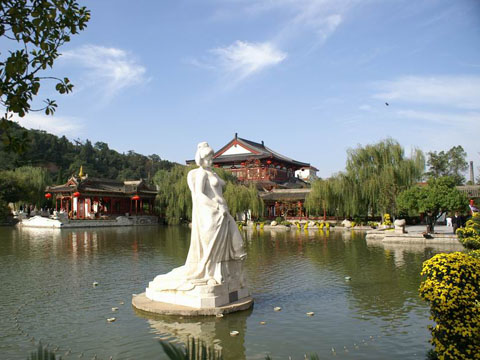 |
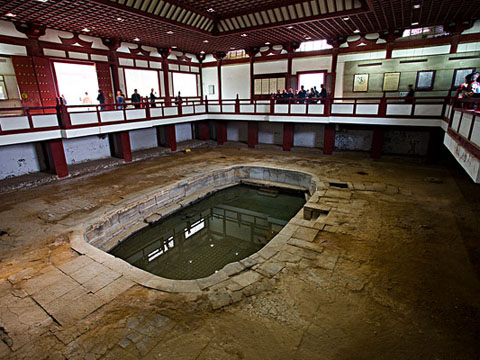 |
Huaqing
Spring Pool |
Hot Spring Pool |
More stories about the Huaqing
Pool:
Huaqing Pool is situated about 35 kilometers east of Xi’an City. Historically,
the Western Zhou Dynasty saw the construction of the Li Palace on the
spot. In the Qin dynasty a pool was built with stones, and was given the
name Lishan Tang (the Lishan Hot Spring). The site was extended into a
palace in the Han dynasty, and renamed the Li Palace (the Resort Palace).
In the Tang dynasty, Li Shimin (Emperor Tai Zong) ordered to construct
the Hot Spring Palace, and Emperor Xuan Zong had a walled palace built
around Lishan Mountain in the year of 747. It was known as the Huaqing
Palace. It also had the name Huaqing Pool on account of its location on
the hot springs.
Huaqing Pool is located at the foot of the Lishan Mountain, a branch range
of the Qinling Ranges, and stands 1,256 meters high. It is covered with
pines and cypresses, looking very much like a dark green galloping horse
from a long distance. So it has the name of the Lishan Mountain (Li means
a black horse).
The Tang dynasty Emperor Xuan Zong and his favorite lady, Yang Gui Fei
used to make their home at Frost Drifting Hall in winter days. When winter
came, snowflakes were floating in the air, and everything in sight was
white. However, they came into thaw immediately in front of the hall.
It owed a great deal to the warm vapor rising out of the hot spring. This
is the Frost Drifting Hall that greets us today.
Close by the Frost Drifting Hall lies the Nine Dragon Pool. According
to legend, the Central Shaanxi Plain was once stricken by a severe drought
in the very remote past. Thus, by the order of the Jade Emperor (the Supreme
Deity of Heaven), an old dragon came at the head of eight young ones,
and made rain here. Yet when the disaster was just abating, they lowered
their guard so much that it became serious again. In a fit of anger, the
Jade Emperor kept the young dragons under the Jade Cause Way, with the
Morning Glow Pavilion and the Sunset Pavilion built at both ends of it
respectively, to make the young dragons spout cleat water all day long
to meet the needs of local irrigation. Besides, he had the old dragon
confined to the bottom of the Roaring Dragon Waterside Pavilion situated
at the upper end of the Jade Causeway, and obliged him to exercise control
over the young.
The Nine-Bend Corridor west of the Nine Dragon Pool leads directly to
the Marble Boat, which resembles a dragon boat on the water surface. In
the Marble Boat lies the Nine Dragon Tang (the Nine Dragon Hot Spring
where Emperor Xuan Zong used to take baths). At the head of his court
ladies and hundreds of his officials, he would come to the Huanqing Palace
to spend his winter days in October of the lunar calendar and return to
Chang’an City as the year drew to its close. The Nine Dragon Hot Spring
was originally built with crystal jade, whose surface was decorated with
the carvings of fish, dragons, birds and flowers. In it twin lotus flowers
also carved with white jade could be seen as well. The spring water effused
from the break of an earthen jar, and spouted up to the lotus flowers.
Hence the name is Lotus Flower Tang (the Lotus Flower Hot Spring).
The Gui Fei Bathing Pool was where Yang Gui Fei, Emperor Xuan Zong’s favorite
lady, used to take bath. It was originally built with white jade, and
in its center blooming flower spouted water like a spring. The pool looked
very much like a Chinese flowering crabapple; Hence its name the Chinese
Flowering Crabapple Hot Spring or the Lotus Hot Spring..
Lady Yang used to make a stay in this pavilion to see sights or to air
her hair after a bath. Therefore, it was named the Hair Airing Pavilion.
Whether the sun was rising or setting, the pavilion was aglow with sunshine;
hence the name the Flying Roseate Pavilion.
Southwest of the Gui Fei Bathing Pool stands a brick-built pavilion. On
its head three big Chinese characters “Xi Jia Lou” (Fine Sunset-Bathed
Pavilion) are inscribed according to the model of the most celebrated
Chinese calligrapher, Yu You Ren, here is the source of the spring water.
At this spa there are four hot springs. They have an hourly flow of 112
tons, and a constant temperature of 43°C. The spring water contains lime,
sodium carbonate, sodium sulphate and other minerals, which makes it suitable
for bathing and considerable treatment of quite a few diseases such as
dermatosis, rheumatism, arthritis and muscular pain. The Fine Sunset-Bathed
Pavilion marks the first source of the spring water, which was discovered
some 3,000 years ago, roughly in the Western Zhou Dynasty. Its water flow
averages 25 tons per hour.
Take up the steps east of the source of hot springs; you will gradually
see the Five-Room Pavilion where Chiang Kaishek made a temporary stay
during the Xi’an Incident.
The Xi’an Incident took place on December 12, 1936, and it is also known
as the Double Twelfth Incident. After the Incident of September 18, 1936,
the Japanese imperialists seized the three provinces northeast of China,
and intensified their invasion of North China. This was the very moment
vital to the Chinese nation. Yet Chiang Kaichek persisted doggedly in
carrying out his reactionary policy “domestic tranquility is a must for
the resistance against Japanese invades,” and commanded the Northeast
Army and Northwest Army, respectively headed by Zhang Xueliang and Yang
Hucheng, to attack the Shaanxi-Gansu-Ningxia Border Region. Inspired by
our Party’s policy “let us stop the internal war and unit to resist the
Japanese aggressors,” those two generals made to Chiang Kaishek the proposal
of forming a united front with the Communist Party for the resistance.
Not only did he reject the proposal, but flew to Xi’an to scheme the “suppression
of the Communist Party.” and the slaughter of the patriotic youth. Out
of patriotism, Zhang and Yang started the famous Xi’an Incident.
Very early on the morning of December 12, 1936 the Incident was impending.
Zhang Xueliang, together with Yang Hucheng ordered a squad of bodyguards
to surround the Huaqing Pool. They fought a fierce battle there, and wiped
out Chiang’s bodyguards in one vigorous effort. The sound of firing came
to Chiang Kaishek, and he was so terrified that he crept out of the window
with his nightgown and slippers only. What’s more, he hurt his spinal
bone, and lost one of his slippers while crossing over the back wall.
He staggered up Lishan Mountain, and hid himself behind a stone in the
crevice halfway on it. Those brave soldiers began to search the mountain
immediately when they rushed into the Five-Room Pavilion to find that
Chiang’s hat and clothes were still there and that his quilt remained
warm. In the end they found Chiang Kaishek, and thus escorted him to Xi’an.
In order to avoid a civil war and try t establish a national united front
for the resistance against Japan, Mao Zedong on behalf of the C.C.P.C.
insisted on a peaceful settlement of the Incident. Therefore, a delegation
headed by Zhou Enlai was sent to Xi’an. Zhou Enlai and his suite did a
large amount of work there, took everything possible into consideration,
and ultimately forced Chiang Kaishek to accept the proposal by his two
generals. On December 25, Chiang was freed, and flew back to Nanjing.
The Xi’an Incident was so peacefully settled.
The peaceful settlement of the Incident put an end to the internal war
which had lasted for ten years, and accelerated the formation and development
of the national united front for the anti-Japanese drive. Moreover, it
showed that the co-operative relationships between the Communist and Nationalists
arrived at a new stage. It marked a great turning point in modern Chinese
history.
In the year of 1946 the KMT government had a “National Rejuvenation Pavilion”
built near the crevice where Chiang Kaishek had hidden himself in the
Incident. It was also called “Vital Energy Pavilion”. After the national
liberation it was renamed “Catching Chiang Pavilion”. Close by the pavilion
stands a wooden board which carries a brief introduction to the Xi’an
Incident. Iron chains and rings in the crevices east of the pavilion,
by which visitors can climb up to take a look at Chiang Kaishek’s shelter.
Up the winding path east of the Five-Room-Pavilion you will catch sight
of a bridge-like construction. It shines regularly with a myriad of evening
sun rays both in summer and autumn, and looks very much like rainbow.
So it has the name of the Hovering Rainbow Bridge.
Located on the Xixiu Ridge (the West Embroidery Ridge) of the Lishan Mountain,
the remains of the beacon tower of the Western Zhou Dynasty seem easy
to identify.
The beacon tower was mostly built at the top of the mountain to give border
alarm in ancient times. It was constantly under special control. Once
the enemies were pressing on towards the border, the beacon tower began
to take effect: it was made to smoke in the daytime while set on fire
at night.
The story goes that Bao Si, Queen of the Western Zhou dynasty was highly
honored, yet she never cracked a smile. King You tried many ways to put
a smile on her face, but he failed over and over again. He “called his
court band to toll bells and beat gongs”, and she pulled a long face.
Then the band was asked to “play the bamboo flute and strings” and she
remained displeased. Afterwards, “maids of honor served wine, festively
singing and dancing,” and she did not let out a smile at all.
“You don’t like music! What on earth are you fond of?” the King asked.
“I nearly have a liking for nothing. But I can still well remember I liked
to give ear to the sound of tearing a piece of colored silk when I was
a child. It was clear and melodious,” she replied. King You said in excitement,
“That is very simple. How come you didn’t let me know it earlier?”
Thus he ordered the officially appointed property manager to offer colored
silk, and made fresh and energetic maids of honor to tear it into pieces.
Hundreds of bolts of colored silk were utterly torn, but Bao Si remained
unmoved.
“Why didn’t you let out a single smile then?” he asked.
“I have never smiled so far,” the Queen replied.
The King tried over and over again, but failed repeatedly, and in the
end he gave orders, “Anyone both in and out of court who can amuse Bao
Si will be awarded one thousand pieces of gold.”
Afterwards Guo Shifu, a treacherous court official came and offered advice:
“Set the beacon tower on fire and fool your sovereign rulers.” That night
the King and Queen reached the Lishan Mountain by carriage, and gave the
order. In the split second the flames of the fire lit up the sky ad the
sovereign rulers moved their troops immediately to the Lishan Mountain.
There they found nothing but that the King and Queen enjoyed drinking
festively. The King then dispatched his bodyguard to inform them that
“Everything should have been all right. I have just been joking with you.”
When they got this, they looked at each other in blank dismay, and left
disappointed. Sure enough, Bao Si burst into laughter, stroking her hands
when she noticed all the troops come in vain and go noisily. Accordingly,
Guo Shifu got a prize of one thousand pieces of gold. Later on King You
did so more often than not. In 771 B.C. Quan Rong (a then minority tribe)
staged an armed rebellion against the Western Zhou Dynasty. King You ordered
urgently to set the beacon tower on fire, but all the sovereign rulers
remained unmoved. Consequently King Yu was killed, and Bao Si was taken
away. The Western Zhou dynasty vanished. Herein, it came the Chinese idiom
“A single smile costs one thousand pieces of gold” and “The sovereign
rulers are fooled by the beacon fire.”
The Banpo Museum is located in the eastern suburb of Xi’an City.
It was built at the base of the excavations of the Banpo Site in 1958.
The Banpo Site is a typical Neolithic matriarchal community of the Yangshao
Culture dating back about 6,000 years ago. At that time, the Banpo people
used tools made primarily of wood and stone. Women, the crucial labor
force, were responsible for making pottery, spinning, and raising the
family, while men fished.
 |
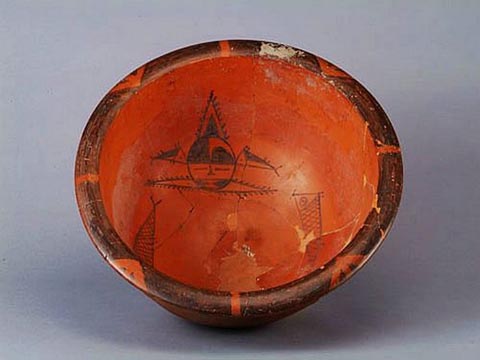 |
Banpo
Museum |
Banpo
Pottry |
The exhibition hall exhibits the unearthed relic exhibitions such as production
tools used by the primitive Banpo People, including axes, chisels, sickles,
and stone and pottery knives. Some potteries and adornments are also on
display.
The Site Hall is about 3,000 square meters and contains residential, pottery
making and burial section. Visitors today can see the remains of 45 houses,
2 stables, more than 200 cellars, 6 kilns, and about 250 tombs and 73
burial jars for Children. It was a matriarchal society based on farming.
The houses were constructed of thatch over wood beams while the floors
were sunk two to three feet into the ground. Heating was provided by a
central fire. Food was stored in underground caves.
The Banpo People worked together. They dug a trench around the entire
complex both for protection and for drainage. There was a large meeting
hall in the center of the village and a place for central storage. Most
of the tools such as axes, hoes, and knives, were made of stone, but some
implements were made of bone such needles for sewing. The stone tools
look remarkably sharp. Art, in the form of geometric designs and human
and animal figures, is found on many of the pots. Some of the pottery
items have marks scratched on them that may be a form of ancient writing.
The potteries produced for drinking, storage, cooking, and burial. The
Banpo Adults were buried in the cemetery outside the village; children
and infants were buried alongside the huts in special clay urns. The reason
for this is still unknown till today.
Banpo Museum offers the visitors a unique view on the Prehistoric Chinese
civilization.
The Basic Exhibition Hall has three exhibition halls. Each of them displays the historical relics by time order from 1.7 million ago to the Qing Dynasty (1644AD-1911AD). These exhibits reflect the evolution of the history of Shanxi Province as well as the epitome of ancient history of China because Xi’an served as the capital for many dynasties such as such as Zhou, Qin, Western Han, Sui and Tang in Chinese history. The Subject Exhibition Hall usually features a variety of theme exhibitions. The exhibitions in this hall are often special to show the history or the culture relics of Shaanxi Province, such as the Shanxi bronze ware, the Shaanxi pottery figure, bronze mirrors, coins and currency, calligraphy, rubbings, scrolls, woven articles, bone articles, lacquer ware, iron and stone objects, seals, Buddhist cultural relics, fresco of tombs as well as some contemporary cultural relics and ethnic objects. The Museum also has one Temporary Exhibition Hall for special exhibitions or contemporary exhibitions.
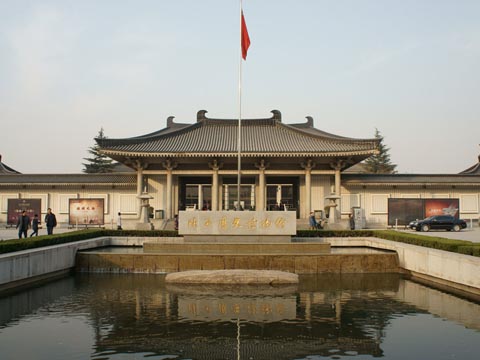 |
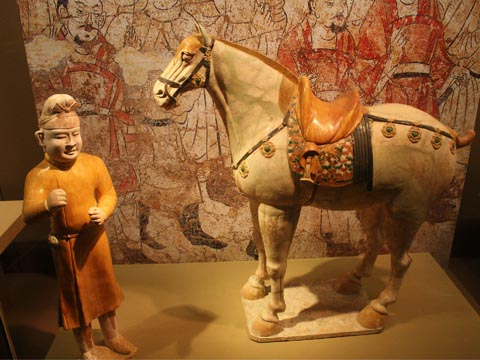 |
Shanxi
Museum |
Tang
Triple color Horse |
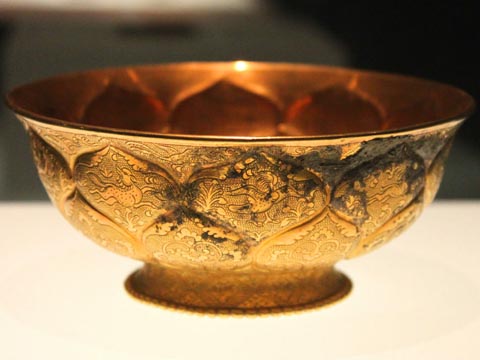 |
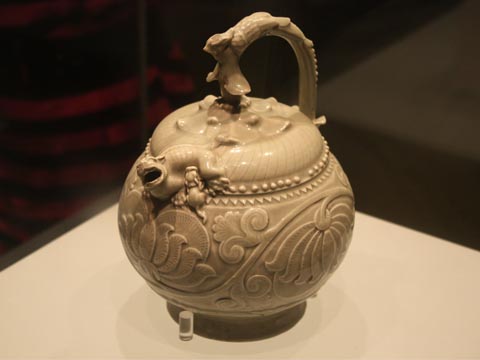 |
Gold
Bowel |
Pocelain |
The contents of the Forest Steles can be divided into four groups: works of literature and philosophy, historical records, calligraphy, and pictorial stones. The Popular Stele of Daqin Nestorianism, which can be recognizable by the small cross at the tip and engraved in 781AD, marks the opening of a Nestorian church. The Monk Bu Kong Stele in Tang Dynasty is noteworthy for its Buddhist value. Collections here are also of high value for exploring Chinese calligraphy history. Here stand the many tablets engraved with works of many outstanding calligraphers through ages. Chinese calligraphy boasts a long history in five basic script forms, namely: seal script, clerical script, regular script, running script and cursive script. Through more than 3,000 years of creative work various forms have constituted the abundant treasure and unique traditions of Chinese calligraphy. The typical includes the Cao Quan Stele, written in Han clerical script famous for its elegant, ingenious inscription; The Tang Dynasty witnessed the prosperous period with noted distinctive styles of regular script. The most distinguished Tang stele is "the Preface to the Holy Buddhist Scriptures" in the handwriting of Wang Xizhi, a famous Jin calligrapher. Some poems of calligraphy are also collected here. Some steles carved the portrait of Confucius with great historical Value.
The Forest of stele is the treasure house to study Chinese calligraphy and history.
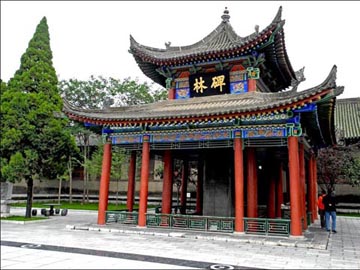 |
 |
Stele
Forrest Museum |
Stele
Inscription |
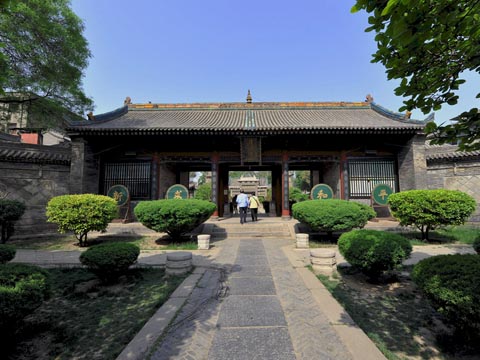 |
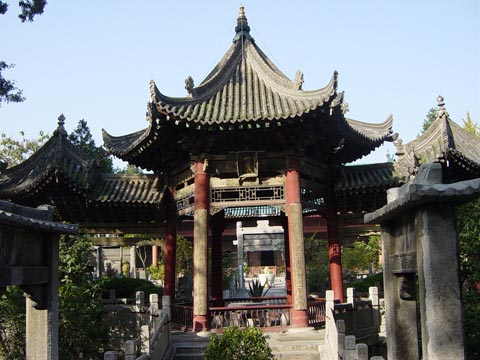 |
Grand
Mosque |
Grand Mosque |
Emperor Qinshihuang’s tomb looks like a large pyramid shaped mound. The bottom of the tumulus is roughly square and the top is flat and spacious. The tomb mound was 115 meters high originally. It was 485 meters from east to west and 515 meters from north to south. But during the last 2000 years it was eroded by rain to the height of 76 meters. The base also becomes smaller. Now the size is 345 meters wide and 350 meters long. The burial chamber is underneath which is
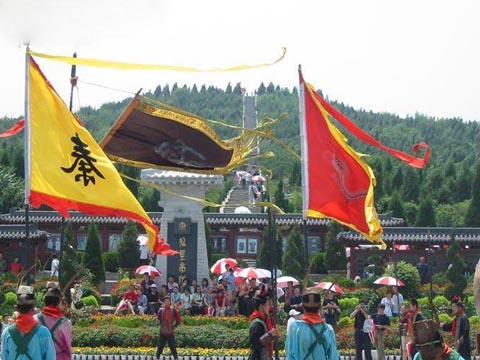 |
 |
Emperor
Qinshihuang's Mausoleum |
Emperor
Qinshihuang |
In an area of 56 kilometers around Emperor
Qinshihaung’s tomb a lot of Qin bricks and tiles, engraved with decorative
patterns were found. A lot of accompany tombs for the Emperor and pits
buried with rare animals, clay figurines, clay horses and bronze chariots
and other sacrificial articles were also found.
It was the strong belief among the ancient Chinese that there was life
in the nether world. The dead should be treated as the alive. Emperor
Qinshihang was the supreme ruler. So his tomb was like the real palace.
He had imitations made of everything he had in his real life. The underground
world was to be the replica of his empire he had ruled. The Terra Cotta
Warriors and Horses mirrored the Emperor’s life and his ambition. He commanded
his army to unify China when he was alive. He still had the army to ward
off his mausoleum. Emperor Qinshihuang’s Mausoleum is not excavated until
today because the present technology cannot protect the burial articles.
We are looking forward to see the day when it is opened thoroughly.
Mobile:(+86-1350
110 3837) Wechat:(13501103837) E-mail: chinasilkrug@msn.com